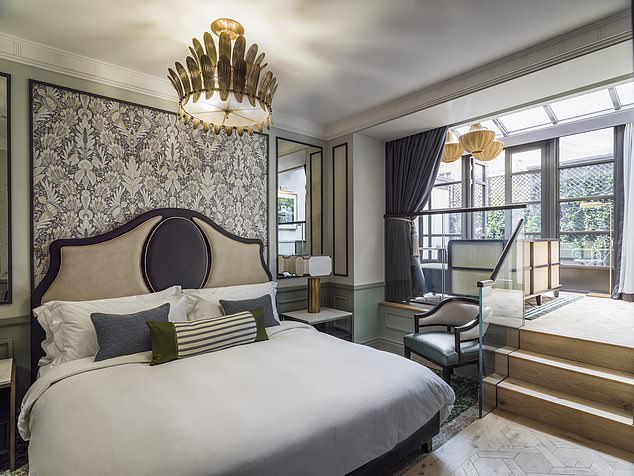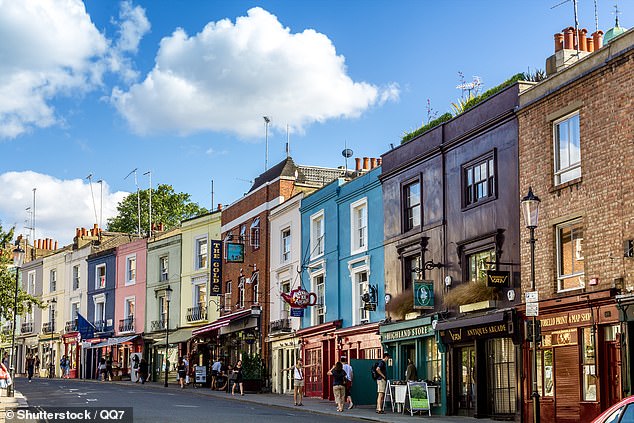There may not have been dancing on the tables at Beaverbrook Town House but there was a buzz that felt just as life-enhancing. Groups of friends were crammed into the booths of Sir Frank’s Bar and couples sat close in The Fuji Grill restaurant. There was laughter, glamour, heels and the glint of jewellery – as if the 1920s had rolled around again and a generation was being set free.
This red-brick building in Chelsea, with concentrated fun and finesse downstairs and 14 bedrooms on the upper floors, is a perfect example of Britain’s latest getaway trend, the townhouse hotel. Overlooking Cadogan Gardens, it is a sibling of the luxury country house hotel in Surrey once owned by newspaper baron Lord Beaverbrook, but it’s not a pastiche of the past.
Tucked away in one side of the restaurant, chef Goemon-san oversees the six-seat omakase restaurant, offering 20 courses of sushi and sashimi, scallops from Scotland, wagyu beef and mackerel, while sake and wine is paired by sommelier Angelique, a former crime scene investigator and weightlifter.

Glamour: Dining at the Beaverbrook Town House in Chelsea
As with all good townhouse hotels, Beaverbrook is about pleasure rather than business. The bedrooms are named after some of the capital’s theatres – I’m in the Haymarket – a clue that this is a hotel that wants you to go out and explore, however fun and colour-filled the decor is.
And it really is, with jewel-coloured velvet sofas, cushions fringed and tassled in a delightfully anti-minimalist way and the corridors lined with vintage posters and prints (beaverbrooktownhouse.co.uk).
Underpinning the townhouse hotel trend is a strong sense of history. For while Beaverbrook Town House references the 1920s, the concept harks back to the 18th Century when landed Georgian families would leave their estates to head to towns for plays, dances and marriage-minded machinations; the very posh precursor of the modern city break.

City slickers: The Garden Suite at the Mayfair Townhouse

The Mayfair doesn’t have a restaurant but light meals can be had in the Dandy Bar
When it opens next year, The Broadwick will champion its Soho location with a full historical romp through the ages, from a boudoir bar to another on the roof and outre decor (broadwicksoho.com). As designer Martin Brudnizki says: ‘We want people to feel as if it’s their second home. It might not be what you want to live with in your home but it’s something that’s fun.’
To get an idea of a more purist approach, Henry’s Townhouse opened in December in Marylebone. In a building thought to have once been owned by Jane Austen’s brother, the seven bedrooms are augmented by art-filled snugs and drawing rooms and while there is no restaurant, a pantry with a refectory table provides breakfasts, private lunches and dinners.

Heritage: The grand frontage of Henry’s Townhouse in Marylebone
Private and intimate, it’s filled with period furniture, including four-poster beds, and paintings (henrystownhouse.co.uk). The Mayfair Townhouse also opened last year in an equally quiet way. It’s larger, with 172 bedrooms, and while there’s no restaurant here either, breakfast and light meals can be had in the Dandy Bar, the private dining rooms or via room service (themayfairtownhouse.com).
‘Townhouses have an air of calm and tranquillity,’ says Andrew Stembridge, the Mayfair’s executive director, ‘but they do need a brilliant, atmospheric bar where guests can gather for a cocktail before hitting town and a nightcap before heading off to bed.’
Just as 18th Century aristocrats liked to move between their country estate and grand bolthole in town, today’s townhouse hotels are often nods to a larger picture. The Mayfair Townhouse is owned by Iconic Luxury Hotels group, and so can be seen as an offshoot of its Cliveden and Chewton Glen estates, while Henry’s Townhouse owner Steve Collins also owns the Temple Guiting estate in the Cotswolds (templeguitingmanor.co.uk).
By looking to its past, Bath – the most fashionable city in the 18th Century – has become the epicentre of the townhouse hotel trend.
The Royal Crescent Hotel, which opened in the 1970s on Bath’s most famous street, has spent recent years – and several million pounds – being returned to its original architectural integrity, which dates back to the late 1700s (royalcrescent.co.uk).
There are newer townhouse hotels here, too, including No.15 by GuestHouse, Bath, on the city’s second-grandest road, Great Pulteney Street.

The Royal Crescent Hotel is located on Bath’s most famous street, pictured above
Artisanal cocktails are concocted at the ground-floor bar, and guests get maps showing them Bath’s most desirable shops and restaurants. The owners, the three Guest brothers, are due to open another hotel in York, while a third hotel in Brighton – another key Regency resort – will open in 2023. James Guest says: ‘The UK has beautiful and thriving cities and we want to help our guests celebrate them as an alternative to a rural getaway.’
With townhouse hotels, decor is largely traditional – a thorough coating of heritage-minded Farrow & Ball paints is standard but with witty touches added.
The best also have a sense of generosity, with free-to-raid minibars generally the norm.
On Portobello Road in lively Notting Hill, West London, The Lost Poet is the most minimal among the townhouse hotel trend. With just four modern rooms and a 21st Century keyless entry system, it has a vibe along the lines of your most stylish friend lending you their pad for the weekend.

The Lost Poet is a four-bedroom townhouse on Notting Hill’s Portobello Road
One townhouse essential is in place during the day, though – a concierge who, after rustling up breakfast in the morning, can help guests plug into the neighbourhood, which includes Holland Park, Portobello Market and the Notting Hill restaurant scene (thelostpoet.co.uk).
Early next year, Gleneagles, one of Scotland’s smartest hotels, will be opening a townhouse in Edinburgh.
Originally the headquarters of the British Linen Company and then part of the Bank of Scotland, the mansion on St Andrew Square is returning to its 18th Century roots, with panelling and grand, canopied bedrooms, plus a rooftop bar and a restaurant that will bring some of Gleneagles’ produce to town (gleneagles.com/townhouse).
TRAVEL FACTS
Sarah Turner was a guest of Beaverbrook Town House, where room-only prices start at £400 a night, and The Lost Poet, where B&B costs £219 a night.
Advertisement
Source link : https://www.dailymail.co.uk/travel/escape/article-10075151/Britains-best-townhouse-hotels-Bath-Edinburgh.html












